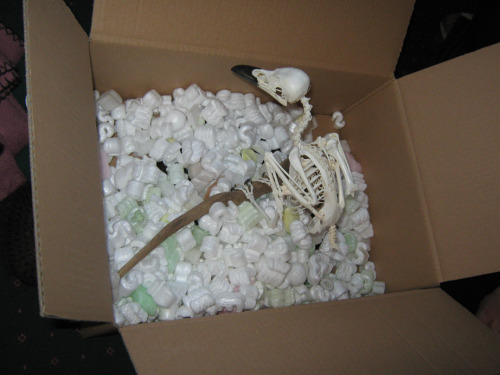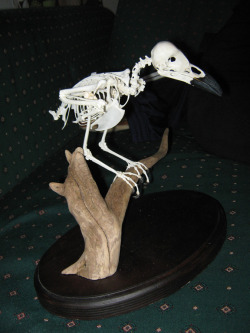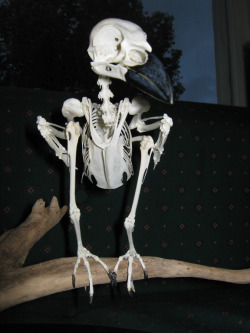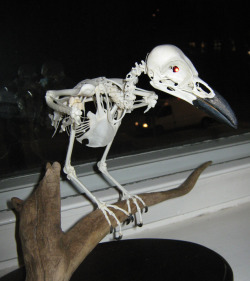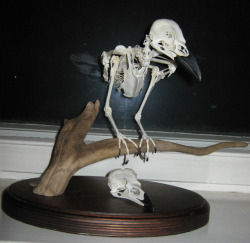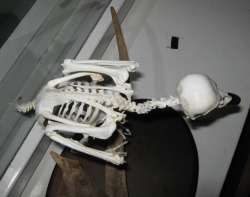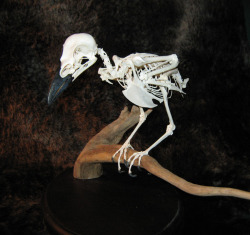This is an article written by Dr. Doug Robinson, a member of the Crow Research Group.
Monday, November 5, 2012
Wednesday, October 31, 2012
Hooded Crow Skeleton
papermonkeyism:
Gorgeous example of a hooded crow (Corvus cornix) skeleton apparently articulated by Luurankoiset.fi. Amazing how tiny birds are once all the feathers are gone! Also note the long neck held in a roughly s-shaped pattern which makes the neck, when covered in feathers, appear “short”. Note the knees as well, held up alongside the chest. Birds DO have knees! Many people seem to think they have a “reverse” knee, but the bend in the leg above the feet is actually the bird’s ankle. A bird walks up on its toes!
Thanks for sharing this Papermonkeyism!
(This is a reblog on Tumblr, so I apologize for any formatting errors once it has been posted on Blogger.)
EEEEEEEEEEEEEEEEEEEEEEEEEEEEEEE!----------------------------------------------------------------
Gorgeous example of a hooded crow (Corvus cornix) skeleton apparently articulated by Luurankoiset.fi. Amazing how tiny birds are once all the feathers are gone! Also note the long neck held in a roughly s-shaped pattern which makes the neck, when covered in feathers, appear “short”. Note the knees as well, held up alongside the chest. Birds DO have knees! Many people seem to think they have a “reverse” knee, but the bend in the leg above the feet is actually the bird’s ankle. A bird walks up on its toes!
Thanks for sharing this Papermonkeyism!
(This is a reblog on Tumblr, so I apologize for any formatting errors once it has been posted on Blogger.)
Tuesday, October 30, 2012
Black/Cape Crow
Not a species you commonly see photographed! A Black/Cape Crow (Corvus capensus) taken by Anja Denker in Namibia, Africa.
Having not seen one in person what I'm noticing is unique about them (via photographs) is a very slender bill and a particularly conspicuous bulge along the throat when calling or possibly displaying.
.
Having not seen one in person what I'm noticing is unique about them (via photographs) is a very slender bill and a particularly conspicuous bulge along the throat when calling or possibly displaying.
.
Monday, October 29, 2012
Split Tongue Myth
One myth I'd like to dispel is that you have to split a pet crow's tongue to make it talk. First off, birds do not use their tongue the same way we do to make sound, in fact birds don't even use their larynx to make vocalizations like we do. Birds utilize their syrynx, which is found in the chest just before the bronchi branch off to each lung. Each bronchi can produce a sound using air vibrating through the external labia and the internal tympaniform membranes. (This means that birds can produce two different sounds at once! It's way cool!) Movement of the avian tongue may change the shape of the mouth as sound is coming out, but not in the same ways as we use our very flexible tongue. So the point is that the tongue (which is fairly rigid in corvids) is not used in creating vocalizations the same way humans do, therefore altering the tongue has nothing to do with the sounds a bird makes or the ability of a crow/raven to mimic human speech. (If you would like to read more about how birds produce sound please click here.)
Most Corvus learn to speak human words, especially when living amongst humans. I have personal theories that it relates to group identity, but let's just go ahead and move on to the cute videos:
White-necked Raven (Corvus albicollis) that could seriously use a bill trim. (Notice that there is a bit of tongue movement likely to alter the shape of the throat as sound goes out.)
White-necked Raven (Corvus albicollis) saying "hello" and "hi" (with a much nicer bill!)
Julian the Common/Northern Raven (Corvus corax) not only mimicking one person saying "What's up", but two different voices.
A crow from the Phillippines, either a Slender-billed Crow (Corvus enca) or a Large-billed Crow (Corvus macrorhynchos). It's surprisingly tolerant to being held like that, haha! It's very cute! And I have zero idea what they are saying.
Pied Crow (Corvus albus) saying the ever popular "Helloooo".
An American crow (Corvus brachyrhynchos) saying quite a lot of things! He/she is quite adorable!
A New Caledonian Crow (Corvus moneduloides), the famous tool makers/users, talking.
A Rook (Corvus frugilegus)...I think it's saying "It looks good."
Common/Northern Raven (Corvus corax) saying, "Say nevermore!", which cracks me up.
Here are a few non-Corvus also mimicking human speech:
A Eurasian Magpie (Pica pica) saying his name and mumbling other things. Way too cute!
A Blue Jay (Cyanocitta cristata) saying her name. (Please note that is is illegal to have a pet blue jay...or any native corvid...as a pet in the United States without federal permitting.)
Eurasian Jay (Garrulus glandarius) talking.
I think that probably covers a bit of the corvids, especially Corvus. No tongue splitting needed!
Most Corvus learn to speak human words, especially when living amongst humans. I have personal theories that it relates to group identity, but let's just go ahead and move on to the cute videos:
White-necked Raven (Corvus albicollis) that could seriously use a bill trim. (Notice that there is a bit of tongue movement likely to alter the shape of the throat as sound goes out.)
White-necked Raven (Corvus albicollis) saying "hello" and "hi" (with a much nicer bill!)
Julian the Common/Northern Raven (Corvus corax) not only mimicking one person saying "What's up", but two different voices.
A crow from the Phillippines, either a Slender-billed Crow (Corvus enca) or a Large-billed Crow (Corvus macrorhynchos). It's surprisingly tolerant to being held like that, haha! It's very cute! And I have zero idea what they are saying.
Pied Crow (Corvus albus) saying the ever popular "Helloooo".
An American crow (Corvus brachyrhynchos) saying quite a lot of things! He/she is quite adorable!
A New Caledonian Crow (Corvus moneduloides), the famous tool makers/users, talking.
A Rook (Corvus frugilegus)...I think it's saying "It looks good."
Common/Northern Raven (Corvus corax) saying, "Say nevermore!", which cracks me up.
Here are a few non-Corvus also mimicking human speech:
A Eurasian Magpie (Pica pica) saying his name and mumbling other things. Way too cute!
A Blue Jay (Cyanocitta cristata) saying her name. (Please note that is is illegal to have a pet blue jay...or any native corvid...as a pet in the United States without federal permitting.)
Eurasian Jay (Garrulus glandarius) talking.
I think that probably covers a bit of the corvids, especially Corvus. No tongue splitting needed!
Thursday, October 25, 2012
Opportunists
 |
| Image from Wikipedia |
Tuesday, October 23, 2012
Fall Crow
A photo I took the other day of an American crow in a maple tree. Figure I'll give folks a nice photo to look at until I can assemble a full post :)
Sunday, October 21, 2012
Welcome To The Corvid Blog!
Welcome to my new blog. My name is Jennifer, but just Jenn is fine. I'm in the 6th year of my PhD working on American crow (Corvus brachyrhynchos) behavior in the wild. This isn't just a degree for me, this is my passion. I love corvids and now I want to share that love with as many people as possible.
This blog is dedicated to all things corvid. However, I will warn you that I am mostly obsessed with genus Corvus, so expect a majority of my posts to be about crows and ravens. I will talk about various studies involving corvids, discuss youtube videos, share photographs and art (my own and other peoples'), and share stories from our study population.
For now, have a photo I took the other day of a crow flying in to some fall maples:
You can also find this blog on Tumblr, if you prefer.
I hope you enjoy the blog!
This blog is dedicated to all things corvid. However, I will warn you that I am mostly obsessed with genus Corvus, so expect a majority of my posts to be about crows and ravens. I will talk about various studies involving corvids, discuss youtube videos, share photographs and art (my own and other peoples'), and share stories from our study population.
For now, have a photo I took the other day of a crow flying in to some fall maples:
You can also find this blog on Tumblr, if you prefer.
I hope you enjoy the blog!
Subscribe to:
Posts (Atom)

